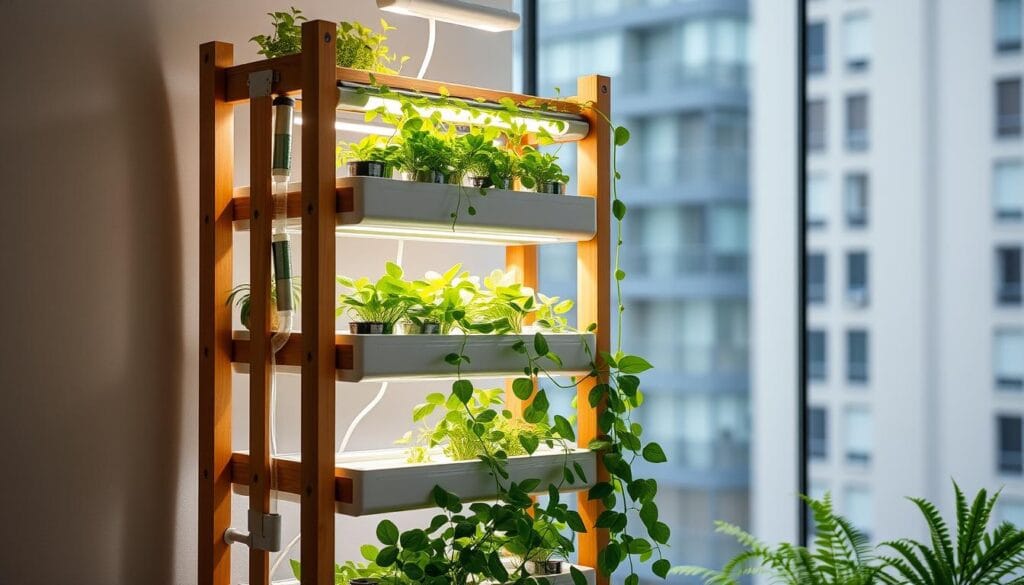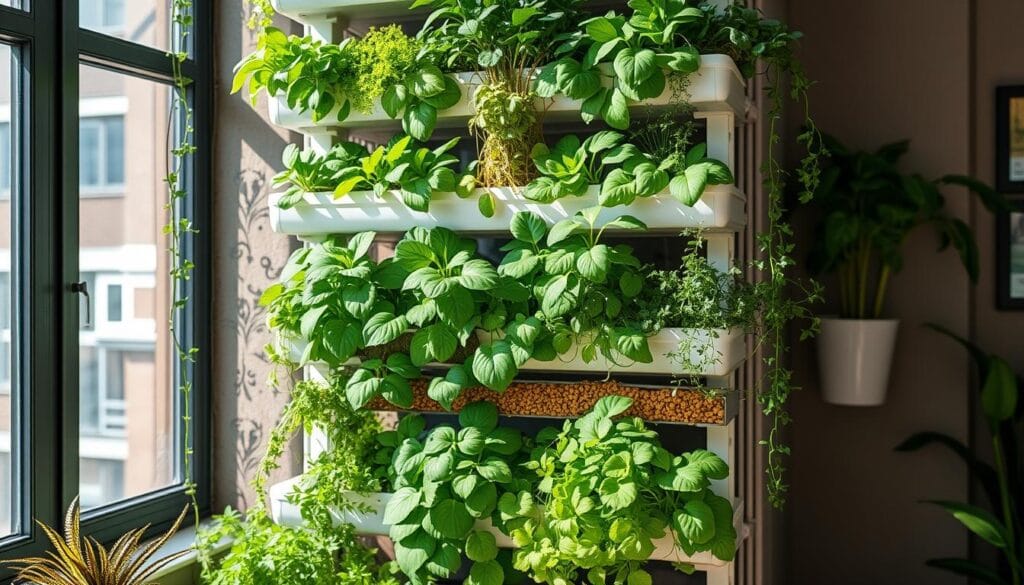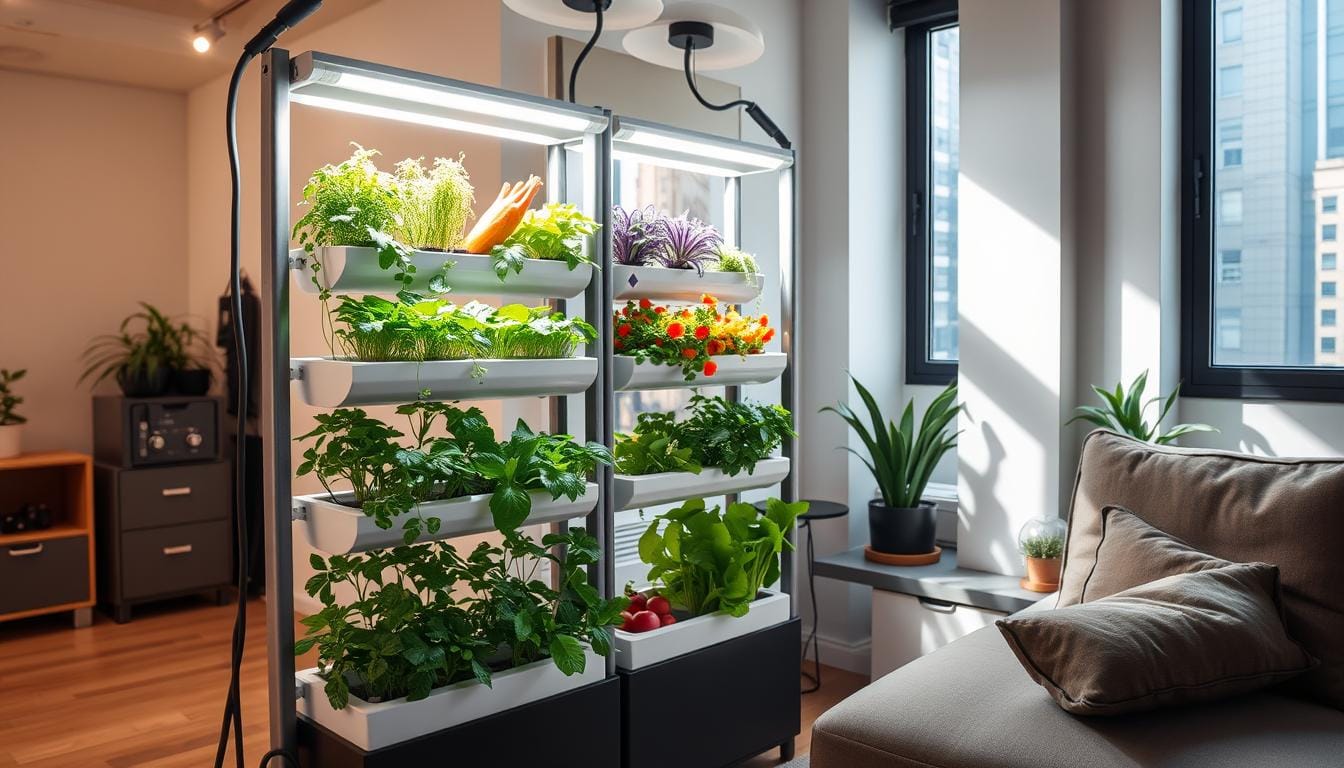Vertical hydroponics turns small areas into lush gardens. You can grow fresh herbs, leafy greens, and fruits in tight spots like balconies or kitchens. This method uses water solutions full of nutrients instead of soil. It helps plants grow faster and produce more.
Building a DIY vertical hydroponic garden is easy. You can use simple materials. It’s great for both experienced gardeners and beginners.
Key Takeaways
- Vertical hydroponics is an efficient way to grow a variety of plants in small spaces.
- DIY vertical hydroponic gardens can be built with simple, cost-effective materials.
- Hydroponic systems use nutrient-rich water solutions instead of soil, leading to faster growth and higher yields.
- Proper setup, maintenance, and monitoring are essential for a thriving vertical hydroponic garden.
- Hydroponic farming can provide a year-round supply of delicious, nutrient-rich produce.
Understanding Vertical Hydroponic Systems
Vertical hydroponic systems are a new way to garden in small spaces. They use less water and more plants, perfect for city living or small yards. You can grow your own food at home with these systems.
Benefits of Soilless Cultivation
Hydroponic gardening is better than growing in soil. It uses much less water, up to 90% less. A small space allows you to cultivate a higher number of plants. Plus, it means less need for harmful pesticides.
Types of Hydroponic Growing Methods
- Nutrient Film Technique (NFT): Great for leafy greens and herbs, NFT keeps a thin film of nutrients over the roots.
- Deep Water Culture (DWC): Plants float in water with nutrients, making it simple and affordable.
- Drip Systems: These systems control nutrients well, good for many types of plants.
- Aeroponic Systems: Plants grow fast in the air, misted with nutrients.
Space-Saving Advantages
Vertical hydroponics is perfect for small spaces. It lets you grow more in less area. Ideal for city living, balconies, or anyone wanting to grow food at home.
Essential Components and Materials
To start a DIY vertical hydroponic garden, you need a few key items. These will help you build a system that grows plants without soil. It’s efficient and functional.
First, you’ll need food-grade buckets or containers for the growing chambers. These buckets hold the nutrient solution and keep your plants safe. You also need net pots to hang your plants over the solution. This lets their roots get the nutrients they need.
The growing medium is very important. You can use clay pebbles, perlite, or coco coir. These materials give your plants a stable base to grow in. A submersible water pump is key for moving the nutrient solution. You’ll also need tubing and connectors for the plumbing in your gardening systems.
You’ll also need a reservoir for the nutrient solution and the nutrient solution itself. Use hydroponic nutrients made for soilless growing. They give your plants the right mix of minerals and vitamins for growth.
For your design, you might add a support structure. This could be made from PVC pipes or a wooden frame. It keeps your vertical garden stable and looks good.
By choosing and putting together these key parts, you’re on your way to a thriving vertical hydroponic garden. It will grow lots of food in a small space.
Planning Your DIY Vertical Hydroponic Garden
Creating a successful indoor vertical garden needs careful planning. You must choose the right location, design an efficient layout, and budget well.
Choosing the Right Location
Start by picking the best spot for your DIY vertical hydroponic garden. Find a place that gets lots of natural light or can handle extra lighting. Indoor gardens do best in bright areas, helping your plants grow well.
Layout and Design Considerations
Think about your plants’ needs when designing your garden. Consider their size, growth, and space needs. Plan the layout to be efficient and easy to maintain, making it simple to care for and harvest your plants.
Budget Planning
Setting a realistic budget for your garden is essential for success. Include costs for the setup, like the structure, hydroponic parts, and growing media. Also, think about ongoing costs like energy, nutrients, and future upgrades. A well-planned budget helps make your gardening journey rewarding and sustainable.
“Vertical gardening is a game-changer for urban dwellers with limited outdoor space. By thinking vertically, you can cultivate a thriving garden in even the smallest of homes.”
Building the Structure and Support System
When you start a diy vertical hydroponic garden, think about the structure and support. Building a vertical space-saving gardens means putting together parts like buckets, bulkhead fittings, and net pots. This makes sure your vertical farming setup is stable and works well.
First, get all the needed stuff, like food-grade buckets, bulkhead fittings, and net pots. Drill holes in the buckets to stop water from overflowing. Make sure the buckets and fittings fit together tightly to keep the water system working right.
- Drill holes for the net pots, spacing them out evenly on the buckets for your plants.
- Put the bulkhead fittings in the holes to seal them tight.
- Connect the buckets up, using a strong frame or support to keep everything steady.
For taller diy vertical hydroponic gardens, you might need a support to keep it standing. You could attach it to a wall, fence, or make a special frame. You can use different bucket sizes or change the layout to fit your space and style.
“Vertical hydroponic tower systems are valued for their efficient nutrient delivery, space-saving design, and ease of maintenance.”

With good planning and building, you can make a space-saving gardens that uses your space well. It also gives you the stability and function you need for your vertical farming project.
Setting Up the Nutrient Delivery System
Creating a good nutrient delivery system is key for a healthy hydroponic gardening systems. It makes sure your plants get the right nutrients, water, and oxygen. This is important for them to grow well and produce a lot.
Pump and Irrigation Components
The heart of the system is a water pump. It moves the nutrient solution through the hydroponic channels or beds. Pick a pump that can handle the water flow rate you need, usually between 1/4 to 1/2 gallon per minute per channel.
Connect the pump to the reservoir with strong tubing. This ensures even automated irrigation across the system.
Water Flow Management
Managing water flow is crucial for your plants’ health. In a Nutrient Film Technique (NFT) system, keep the water depth very shallow. It should be just a millimeter or two, with a slope ratio of 1:30 to 1:40.
This setup lets the nutrient solution flow constantly. It gives your plants a steady supply of nutrients and oxygen.
Nutrient Solution Preparation
Follow the maker’s instructions to mix the nutrient solution right. Check the pH and adjust it if needed. This helps your plants absorb nutrients well.
Regularly test and tweak the nutrient solution. This keeps the best conditions for your plants to flourish.
“Proper nutrient delivery is the foundation of a successful hydroponic garden. By setting up the system with care and attention, you’ll ensure your plants receive the nourishment they need to grow lush and bountiful.”
Plant Selection and Growing Medium
When setting up your DIY vertical hydroponic garden, picking the right plants and growing medium is key. Choose plants that do well in vertical farming and indoor gardening setups. This will help your garden thrive.
Leafy greens, herbs, and small fruiting plants are great for hydroponic gardening systems. They grow well in vertical spaces. Think about their light needs, how long they take to grow, and how much space they need.
- Leafy greens like lettuce, spinach, kale, and Swiss chard grow well in vertical gardens.
- Herbs such as basil, thyme, rosemary, and mint are small and flavorful for indoor gardens.
- Small fruiting plants like cherry tomatoes, dwarf peppers, and strawberries also do well in vertical systems.
The growing medium is crucial for your plants’ roots and keeping moisture. Choose media like clay pebbles, perlite, or coco coir. They offer good drainage, air, and water retention.
| Growing Medium | Key Benefits |
|---|---|
| Clay Pebbles | Excellent drainage, pH neutral, and reusable |
| Perlite | Lightweight, improves aeration, and retains moisture |
| Coco Coir | Renewable, biodegradable, and provides good water retention |
By picking the right plants and growing medium, you can make a successful vertical hydroponic garden. It will use space well, be productive, and be a success in indoor gardening.

Lighting and Environmental Control
Getting your vertical hydroponic garden to grow well is more than just the setup. You also need the right light and control of the environment. These are key to your success in indoor gardening.
Natural vs Artificial Light Requirements
Most plants need at least 6 hours of direct sunlight a day to grow well. If your vertical garden doesn’t get enough sunlight, you’ll need plant growth lights. Place the lights right above your hydroponics system for even light and the right intensity for your plants.
Temperature and Humidity Management
Keeping the right temperature and humidity is also vital for your indoor gardening. Watch these factors closely and adjust as needed for the best growing conditions. Use fans for air movement and make sure there’s good ventilation to avoid mold.
Studies by Wageningen University & Research show that a dynamic approach to environmental control in vertical farming can cut energy costs. It can also help plants grow better.
| Environmental Factor | Optimal Range |
|---|---|
| Temperature | 68°F to 77°F (20°C to 25°C) |
| Humidity | 50% to 70% |
By managing these environmental factors well, you can make your indoor garden thrive. This will help you get the most out of your vertical hydroponic setup.
“Responsive control of factors such as light intensity and temperature in both traditional greenhouses and vertical farming systems can benefit from sustainable energy sources like solar and wind energy, thus maximizing efficiency and cost savings.”
System Maintenance and Monitoring
Keeping your vertical hydroponic garden healthy needs regular care. It’s important to check the pH and electrical conductivity (EC) levels of the nutrient solution often. Adjust these levels as needed to make sure your plants get the right nutrients.
To replace water lost through evaporation and plant use, refill the reservoir with plain water regularly. Also, change the nutrient solution every 1-2 weeks to keep your plants healthy.
Cleaning the system parts is key to avoid clogs and algae. Check the tubing, pump, and other parts for wear or blockages. Fix any problems quickly to keep your system working well.
Watch for pests or nutrient deficiencies in your plants. Quick action can help your garden thrive. With regular maintenance and monitoring, your hydroponic systems will keep giving you a good harvest.
| Hydroponic System | Pros | Cons |
|---|---|---|
| Drip |
|
|
| Wick |
|
|
| Aeroponic |
|
|
| Deep Water Culture (DWC) |
|
|
| Nutrient Film Technique (NFT) |
|
|
Remember, the key to a successful vertical hydroponic garden is consistent maintenance and monitoring. By staying vigilant and addressing any issues promptly, you can ensure your hydroponic gardening systems continue to thrive and provide a bountiful harvest.
Conclusion
Vertical hydroponics is a smart way to grow plants in small spaces. By following a few steps, you can have a vertical hydroponic garden that gives you fresh food all year. It’s great for saving space, using less water, and growing more plants.
As you get better, you might want to try new things like automation. This can make your space-saving gardens even better.
To make a diy vertical hydroponic garden work, you need to know the basics. Plan your setup well and take care of it. This way, you can grow lots of plants in a small area. You’ll always have fresh, healthy food.
If you live in the city or have a small patio, a DIY vertical hydroponic garden is perfect. It’s a great way to grow your own food. With some effort, you can enjoy the fruits of your labor right at home.

